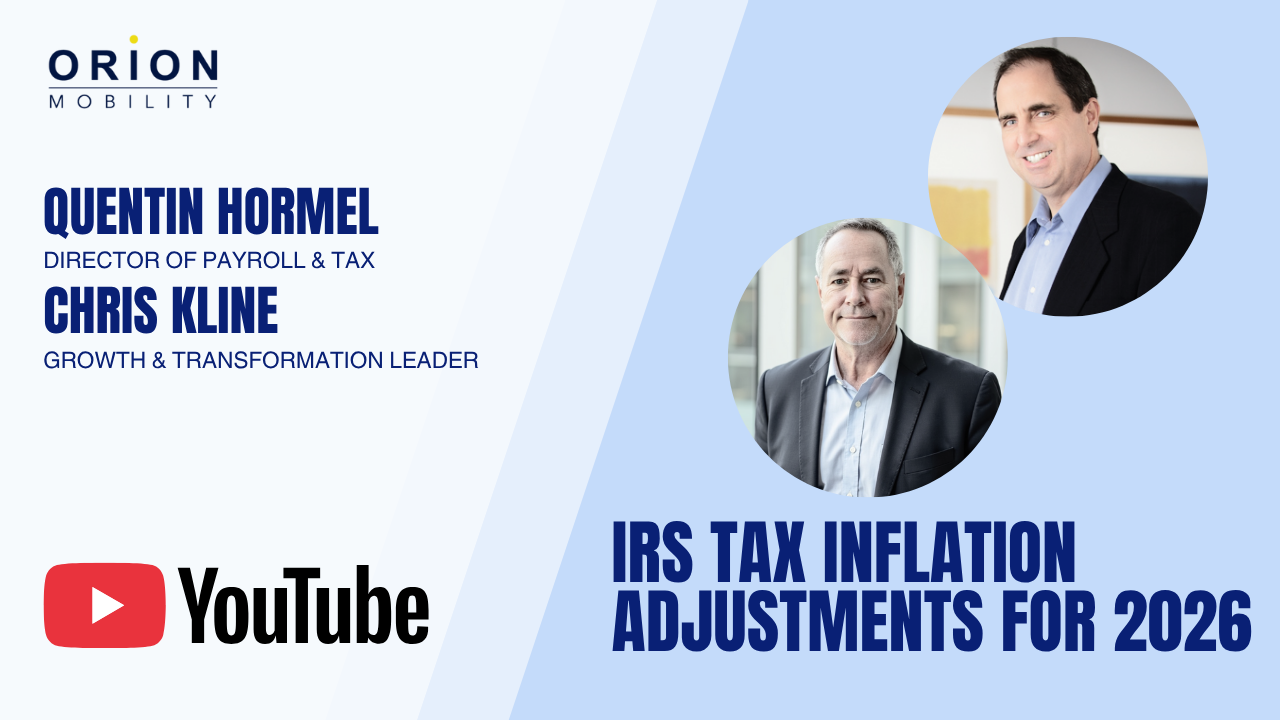Expert Commentary: Insights from Orion’s Payroll Director and Transformation & Growth Leader
In a recent conversation, Chris Kline, Orion’s Transformation & Growth Leader, sat down with Quentin Hormel, Payroll and Tax Director, to discuss the latest IRS tax law updates and their impact on mobility programs including the newly enacted “One Big Beautiful Bill” and the 2026 inflation adjustments.
Watch the Full Discussion
Hear it directly from Quentin Hormel and Chris Kline as they unpack how the One Big Beautiful Bill and the 2026 IRS inflation adjustments will shape relocation programs in the years ahead. Click on the image below.
1. Making the 2018 Tax Cuts Permanent
Quentin explained that most of the One Big Beautiful Bill simply makes permanent many of the temporary provisions passed under the 2018 Tax Cuts and Jobs Act (TCJA).
“A lot of the changes were scheduled to expire in 2025,” he noted. “But the new bill essentially locks in those lower rates and key provisions beyond 2026.”
For mobility professionals, that means the elimination of the moving expense deduction — which many hoped might return — is now permanent.
“Van line bills, storage, and final move expenses remain taxable to employees, except for qualified military moves,” Quentin clarified.
He also pointed out that while some states still allow deductions following pre-2018 rules, the number has dropped to about six states today.
2. Relocation Costs and Gross-Up Implications
Chris highlighted that the removal of moving expense exclusions has significantly increased the total cost of relocations.
“You’ve essentially increased the cost of a move by 50 to 60% once you factor in gross-ups,” he observed.
Quentin agreed, explaining that depending on methodology and income level, gross-up factors can range widely — from as low as 20–25% for lower-income transferees to more than 100% for high-income earners in states like California.
“On average, it’s closer to 55–60%,” Quentin said. “It really depends on whether a company uses marginal rates or a flat supplemental rate.”
3. Why Methodology Matters
The discussion underscored the importance of using the right gross-up methodology.
“Some employers use a one-size-fits-all flat rate,” Chris noted, “but Quentin recommends a marginal approach.”
Quentin elaborated that while flat supplemental rates (like 22%) are simpler and compliant, marginal rates create a fairer, more accurate reflection of each employee’s actual tax burden.
“You may be over-grossing your new hires and under-grossing executives if you apply the same rate across the board,” he said.
4. FICA, Compliance, and Timing
Quentin also cautioned that FICA thresholds are often overlooked — a costly mistake for employers.
“If someone has already hit their FICA cap and you continue to gross up as if they haven’t, you’re giving away unnecessary dollars,” he explained.
He and Chris also stressed the importance of timely tax reporting.
“Some companies still wait until year-end to process relocation expenses,” Quentin said. “That’s risky — the IRS requires reporting at the time of payment.”
Chris added that handling relocations quarterly or monthly helps prevent compliance gaps and reduces year-end corrections.
“Waiting until December creates data issues and late filings,” he warned. “Building in an extra payroll cycle at year-end can help avoid W-2C corrections.”
5. Technology and Accuracy
The conversation closed with a look at Orion’s proprietary tax and gross-up system, which automates federal, state, and local calculations with precision.
“Some third-party systems apply blanket assumptions that lead to over-grossing,” Quentin said. “Our software accounts for each state’s specific tax rules — even for items like new residence points or mortgage interest.”
Chris concluded by reminding viewers that Orion offers a complimentary gross-up audit to help companies benchmark their process and uncover cost-saving opportunities.
“We’ll run your data through our tax engine and show you exactly where you can improve,” he said. “There’s no charge — just insight.”

